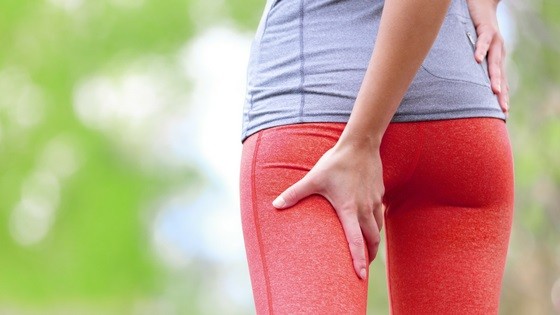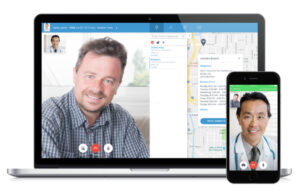Treating and Preventing Muscle Cramps during Exercise
Exercise-induced muscle cramps are painful, debilitating, and can take an athlete out of the competition. They can occur in athletes in all types of sports and are usually associated with muscle fatigue and/or dehydration with an associated loss of electrolytes. It is not uncommon to see an athlete drop to the ground in agony near the end of a competition due to muscle cramps in his/her legs.
The muscle cramping is commonly seen in the gastrocnemius/soleus (lower leg) muscles and in the hamstring muscle groups. Even when the muscles are immediately stretched to relieve the muscle cramping, the cramping often returns as soon as the athlete engages the muscle. Sometimes, it is even as soon as when the athlete takes his/her first step. Because of the severity of the cramping, this condition can often end the day’s competition for the athlete.
What are the causes of muscle cramping?
According to a recent review of the literature on the causes of muscle cramps during exercise published by the American College of Sports Medicine (Bergeron, 2008), there appear to be two possible causes for muscle cramping in athletes. Although further research is needed to better understand the underlying physiology of both, the literature provides a basis for understanding the problem and how to prevent muscle cramps from occurring.
The first category of exercise associated muscle cramps is related to skeletal muscle overload and fatigue. According to this theory, the neuromuscular systems imbedded in the muscles for the purpose of maintaining safe control of muscle contraction are affected. According to this theory, the part of the neuromuscular system that initiates contractions is increased (hyper-excitement of muscle spindles) while the part of the neuromuscular system that inhibits contractions is decreased (Golgi tendon organ). With the Golgi tendon organ inhibited, the muscle is inundated with messages to contract by the afferent muscle spindle (brings messages from the brain to the muscle).
Muscles that are overused and fatigued may be at a higher risk for muscle cramping due to the effects of the fatigue on the neuromuscular system.
What is unique about this type of muscle cramping is that it would only affect the specific muscles that are fatigued and one would not see a generalized system muscle cramping as one would see with a case of dehydration-based muscle cramping.

The second category of exercise-associated muscle cramps is better understood and com
monly recognized as a cause of muscle cramping in athletes.
The second type of cramping is caused by excessive sweat losses associated with a decreased level of electrolytes (specifically sodium).
Electrolyte deficit-related muscle cramps are sometimes the first level (of three progressive conditions) associated with heat illness. The body has a complex system for cooling itself as the core temperature of the body begins to increase with exercise and an increase in the outdoor temperature.
The body primarily cools itself using two specific systems.
The first is by redirecting its blood supply out towards the surface capillaries in the skin. As the blood is routed towards the surface, the blood is cooled as it travels just under the skin as it comes into contact with the ambient temperature.
The second system is by sweating. Sweating cools the body by releasing the body’s water onto the skin’s surface. With evaporation of sweat, heat is transferred from the body through an exchange of energy to the air. As the athlete moves, the air comes across the moist skin and cools the body through convection. However, the process of sweating is typically the primary means of maintaining the body’s temperature in a safe range.
As the water and sodium content of the body decreases through sweating, the muscles can begin to systemically cramp. Sodium is the key electrolyte in the formula because sodium helps the body to retain water, especially in the muscle fluid spaces. Without a high enough concentration of sodium, the water that the athlete drinks is excreted without being distributed throughout all of the body’s fluid compartments.
What are electrolytes and why are they linked to muscle cramping?
Electrolytes are minerals that dissolve in the body as electrically charged particles. They include sodium, chloride, magnesium, and potassium. Electrolytes have a direct effect on muscle cramping because they regulate fluid balance, nerve conduction, and muscle contraction.
A common myth associated with treating muscle cramps is that the consumption of bananas can alleviate the cramping. Although it is a commonly practiced “remedy”, there is no evidence to support the use of bananas to effectively prevent or treat muscle cramps.
What might make an athlete more susceptible to muscle cramping?
Factors that have been associated with increasing the risk of muscle cramping in overload or fatigue-related muscle cramping include the following:
• Older age
• Poor stretching habits
• Insufficient conditioning
• Cramping history
• Excessive exercise intensity and duration
• Metabolic disturbances
According to the research presented by Bergeron (2008), several factors may be involved with causing muscle cramping in dehydrated athletes with sodium deficits.
These factors directly affect the body’s sodium content.
• Sweat rate of the athlete
• Sweat sodium concentration of the athlete
• Dietary intake of the athlete
The importance of these factors is that they are absolutely unique to the individual athlete. Some athletes are prone to cramping and others are not. The answer lies in the factors listed above. Some athletes just sweat a lot. While performing the same level of activity, some athletes will be dripping with sweat and others will be relatively dry. This can be seen in both genders. If an athlete has a high sweat rate during activity, this athlete may be susceptible and be at greater risk for muscle cramping.
Sweat sodium concentration is another factor that is unique to the individual athlete, that is, the amount of sodium contained in the athlete’s sweat. Some athletes have a high sweat sodium concentration. These athletes may actually leave salt residue on their skin or clothes after a workout. If an athlete has a higher sweat sodium concentration, this athlete may also be susceptible and be at risk for muscle cramping.
Although other electrolytes are lost in sweat, their concentration and consequent total loss via sweating is not enough to prompt muscle cramping or other problems. The electrolytes most commonly blamed for muscle cramping include calcium, magnesium, and potassium. However, the review of the literature by Bergeron (2008) did not substantiate any of these electrolytes as possible causes of muscle cramping.
How can I treat muscle cramps?
The effective treatment of muscle cramps is dependent on the cause. For athletes suffering from overuse or fatigue muscle cramps, the most effective treatments are passive stretching, massage, icing of the affected muscles, and contraction of the muscle on the opposite side of the muscle cramping (i.e., if the hamstring is cramping, contract the quadriceps muscle group to relax the hamstring muscle group).
Contracting the muscle opposing the cramping muscle is based on the physiological principle of reciprocal inhibition. When a muscle contracts (agonist) the opposite muscle (antagonist) automatically relaxes to allow for the contraction.
Athletes suffering from fatigue-related muscle cramps will not be able to continue their activity without further cramping. These athletes need time for their muscles to heal and recover before trying to compete again.
For athletes suffering from muscle cramps prompted by excessive sweating and a sodium deficit, the same treatments as above can be immediately applied to reduce the pain and muscle spasm. However, along with the stretching, massage, and applied ice, these athletes need to consume fluids with additional sodium.
According to Bergeron’s (2008) research, immediate consumption of a “.5L carbohydrate-electrolyte drink with 3.0g of salt added and thoroughly mixed consumed all at once or over 5 – 10 minutes” has proven successful at relieving muscle cramps and preventing future severe cramping. As the cramping resolves, these athletes may be able to continue competing at their normal intensity.
How much should I drink after a competition if I had muscle cramping?
Once the activity is completed, the athlete needs to continue to consume electrolyte-containing fluids. According to McArdle, W.D., Katch, F.I. & Katch, V.L. (2006), prolonged exercise and sweat loss can deplete the body of “13 to 17g of salt (2.3 to 3.4 g per L of sweat). Sodium can be replaced by adding about one-third teaspoon of salt per one liter of water.
The goal after exercise is to replace the water and electrolytes lost during the activity. One method to determining the amount of fluid lost is to weigh the athlete before and after activity. This is good practice, especially in hot temperatures to help prevent serious heat illness in the athletes from accumulating water deficits.
How much should I drink before an activity to prevent muscle cramping?
Because thirst is not often a sufficient stimulus to maintain adequate fluid balance during exercise, adequate fluids need to be consumed prior to exercising.
The athlete should maintain good hydration at all times. To assist in adequate hydration during exercise, the athlete should consume 17 – 20 ounces of water or sports drink 2 to 3 hours before the activity. If possible, another 7 – 10 ounces should be consumed 10 – 20 minutes before the activity.
However, unless the fluids contain a sufficient amount of sodium, “excess fluid intake merely increases urine output” (McArdle, W., Katch, F.I., & Katch, V. L., 2006) and will not be retained by the body.
How much should I drink during an activity to prevent muscle cramping?
Although historically, coaches may have withheld water as a punishment for their athletes, it is currently supported by the sports medicine community that athletes should have access to water throughout their activity. If water is not provided by the coach/school, young athletes should bring their own water bottle labeled with their name.
To maintain hydration, it is recommended that adult athletes drink up to 1.5 L or about 50 ounces per hour. If athletes are prone to excessive sweating and sodium loss, this may need to be increased on an individual basis.
Again, because thirst is not often a sufficient stimulus to maintain adequate fluid balance during exercise in the heat, coaches need to be proactive in ensuring that their athletes replenish their fluids on a consistent basis.
Because of the life-threatening nature of dehydration leading to heat illness, coaches that withhold water should be confronted about the dangerous practice and reported to the administration of the sports organization. Withholding water from athletes is considered a form of athlete abuse and should not be tolerated at any age level.
Can the use of diuretics affect exertional muscle cramping?
Diuretics are contraindicated for an individual who is active and participating in sports. Diuretics can increase the body’s fluid loss and contribute to dehydration. While there are prescription diuretics that can be taken to reduce body fluids, athletes may be consuming products that act as diuretics and not be aware of it.
As a coach, what can I do to reduce the risk of dehydration in my athletes?
Preventing dehydration and muscle cramps in athletes starts with educating the athletes and their parents as to the importance of adequate hydration before, during, and after activity.
Just as important as adequate volume of fluid intake is the appropriate types of beverages athletes should drink before, during, and after exercise. Water can be sufficient in many cases and circumstances; but as sweat losses increase, the sodium content of the rehydration beverage becomes more important.
Strategies that coaches can implement to reduce the risk of dehydration include:
• Encourage the athletes to refrain from drinking caffeinated beverages including sodas, coffee drinks, and tea
• Educate the athletes and their parents as to the dangers of consuming energy drinks loaded with high levels of caffeine and its affect on the athlete’s body
• Have unlimited water available during practice/competition
• Record pre and post-exercise weight to determine if excessive and unsafe weight loss has occurrance
• Replenish lost fluid with up to 20 ounces of fluid for every pound of body weight lost
• Encourage sports drinks in sports that are endurance- based rather than just water
• Monitor athletes closely on hot days looking for signs of possible heat illness
• Reduce risk of heat illness by reducing equipment worn during practice and by changing practice times
If you suspect you have problems with muscle cramps during exercise, it is critical to seek the urgent consultation of a local sports injuries doctor for appropriate care.
Virtual Care from Sports Doctors and Specialists
 SportsMD offers Virtual Care and Second Opinion Services. It allows you to quickly and conveniently speak with a sports doctor or specialist and have an effective alternative to emergency room, urgent care, or waiting for a doctors appointment. You can get Virtual Care from your home or anywhere via phone or video chat.
SportsMD offers Virtual Care and Second Opinion Services. It allows you to quickly and conveniently speak with a sports doctor or specialist and have an effective alternative to emergency room, urgent care, or waiting for a doctors appointment. You can get Virtual Care from your home or anywhere via phone or video chat.
References
Anderson, M.K., Parr, G.P., & Hall, S.J. (2009). Foundations of Athletic Training: Prevention, Assessment, and Management, (4th Ed.). Lippincott Williams and Wilkins: Baltimore, MD.
Bergeron, M.F. (2008). Muscle cramps during exercise – is it fatigue or electrolyte deficit? Current Sports Medicine Reports: Supplement – Sodium Balance and Exercise 7(4) S50-S55.
Landry, G.L. & Berhardt, D.T. (2003). Essentials of Primary Care Sports Medicine. Human Kinetics: Champaign, IL.
McArdle, W.D., Katch, F.I. & Katch, V.L. (2006). Essentials of Exercise Physiology (3rd Ed.). Lippincott Williams & Wilkins: Baltimore, MD.

